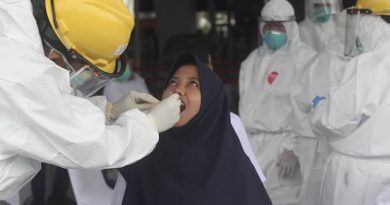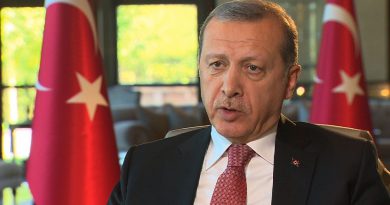“I Can’t Breathe!” say Afghan Refugees in Iran
by Bagher Ebrahimi
Iranians and Afghans have also been confronting systemic prejudice, racism and violence close to home, horrified by Iranian authorities’ treatment of Afghan migrants.
A group of Afghan artists and activists has shown solidarity with worldwide demonstrations against the murder of George Floyd and drawn attention to the plight of Afghan migrants by erecting a mural in one of the busiest areas of Kabul.
The latest work by the Afghan Honar-Salar art group, which has used street art for its civil society and human rights messages for several years, appears on the wall of the Afghan National Security Building, and juxtaposes George Floyd, who was killed on May 25 by police in Minnesota, with Afghan migrants killed by patrol guards on the border between Iran and Afghanistan.
Afghan citizens and political figures shared photographs of the painting of an unnamed individual holding up the Iranian flag next to a man with a banner that reads “We Can’t Breathe” on social media. At the bottom of the mural is a group of people drowning.
The phrase echoes the words of George Floyd, who was heard saying “I can’t breathe” as a policeman pinned him down with his knee in Minnesota, leading to his death and sparking demonstrations against racism around the world.
Over the last month, Iranians and Afghans have also been confronting systemic prejudice, racism and violence close to home, horrified by Iranian authorities’ treatment of Afghan migrants. First, in early May, Iranian border patrol guards caused the deaths of at least 18 migrants by forcing them into the Harirud River. A month later, on June 3, Iranian police fired shots at a vehicle carrying Afghan migrants in Yazd that led to the death of five of them and to several others being injured.
On May 2, Afghan news agencies reported that more than 50 Afghan migrants had been detained and beaten by Iranian guards as they crossed the border, with some reports saying that as many as 70 people were trying to enter Iran. Guards forced them to jump into the Harirud River, which runs along the Iran-Afghanistan border. Survivors say that at least 23 people died. The Afghan Independent Human Rights Commission (IHRC) later said that at least one child was among those killed.
Images and videos of the police attack on a car carrying Afghan migrants have been published by the media and widely shared, along with photographs of those injured in the attack being chained to their hospital beds.
Protest rallies followed, and the incident was widely discussed among Afghanistan’s politicians.
Initially, the Islamic Republic denied the Harirud River tragedy, though officials did acknowledge the second incident in Yazd, claiming the police had suspected that people in the car were in possession of illegal drugs. Following the attack on the car, Afghans publicly mourned the death of their fellow citizens, not only taking to the street in protest or demonstrating outside the Iranian embassy, but also reading poems in public, and, as with George Floyd, calling out the last words of some of the victims: “Bring water, I’m on fire.”
So far, no one has faced criminal prosecution for either tragedies.
Solidarity Through Art
The Honar-Salar group has used art to voice its outrage against racism around the globe and the Islamic Republic’s systemic persecution of Afghan citizens living in, and trying to enter, Iran. When the Honar-Salar group’s mural protests coincided with anti-racism demonstrations around the world, the artists felt compelled to join in, and also knew it was also an opportunity to raise awareness of the plight of Afghan migrants.
“Through painting, we wanted to convey to people that not only Afghans face racial discrimination,” Abrar Kakar, the head of programs at the Honar-Salar Art Group, told IranWire. “The assassination of George Floyd and what happened to Afghan refugees in Iran are both because of racial discrimination.”
He says the murals seek to narrate the pain of millions of Afghans and portray the “pains and injustices” of Afghan society and the “discrimination and violence” the Islamic Republic uses against Afghan immigrants. “In order to respect human values and make citizens aware of this, we must talk and solve such problems through dialogue.”
Abrar Kakar described the actions against Afghans as “unbearable.” “We were all affected. It was very painful. That’s why we couldn’t keep quiet and wanted to do something in the hopes that we could prevent such accidents in the future.”
He says the group tried to paint the mural on the wall of the Iranian embassy, but they were stopped; neither the Afghan security services or the Iranian embassy would issue a permit for it to go ahead.
Abdul Hakim Maghsoudi helped create the mural. “The art of painting plays a very important role in conveying the message,” he told IranWire. “In this way, we send our message against discrimination to all the people of the world. During the five years I’ve been working with the group, I’ve done a lot of wall paintings. Art is very good; the message we convey through our art is the need to reduce violence and discrimination.”
Most of Maghsoudi’s paintings look at social harms, including violence against women, lack of education, and racial discrimination, as well as at issues such as rampant corruption within political institutions.
He says the mural has prompted many reactions, and is part of a larger process of breaking the silence over racial discrimination and, crucially, holding those responsible legally accountable. “This mural in front of the Afghanistan National Directorate of Security has attracted the attention of and been widely welcomed by the citizens of this country. Our group hopes that we can convince people not to remain silent in the face of racial discrimination and to complain and speak up and demand legal action be taken in these cases.”
Around the world, street art plays an important role in raising awareness about injustice, using creativity and art to give people a voice and bring about change. In Afghanistan, the mural that puts George Floyd alongside the victims of the Islamic Republic’s brutality is an important act, an attempt to spark discussion and show the world that the Islamic Republic’s racial discrimination against Afghan citizens and immigrants must not continue.
Article first appeared on IranWire.



